
Guests
- Blanche Wiesen Cookauthor of the award-winning best-seller Eleanor Roosevelt, Vol. 1: 1884-1933, and the most recent Eleanor Roosevelt, Vol. 2: 1933-1938 (published by Viking Press), speaking from Boston.
First lady Hillary Clinton filed yesterday with the Federal Election Commission to form an exploratory committee for a Senate race in New York, taking the formal step toward being the first wife of a sitting president to be running for office.
Today, Mrs. Clinton, who has never lived in New York, is beginning a four-day “listening tour” through central New York, starting at departing Senator Daniel Moynihan’s farm in Delaware County and continuing through the heartland of the state.
Hillary Clinton often says that one of her models is Eleanor Roosevelt. Aside from having a philandering husband who is president of the United States, she has also been deeply involved in his political career since its hatching.
Today, we are going to take a look back at Eleanor Roosevelt — until now the most well-known first lady in the history of the United States.
Transcript
AMY GOODMAN: You are listening to Pacifica Radio’s Democracy Now!, as we continue with today’s program.
First lady Hillary Rodham Clinton filed yesterday with the Federal Election Commission to form an exploratory committee for a Senate race in New York, taking the formal step toward being the first wife of a sitting president to run for office. Today, Hillary Rodham Clinton, who’s never lived in New York, is beginning a four-day listening tour through the central area of the state, starting at departing Senator Daniel Patrick Moynihan’s farm in upstate Delaware County and continuing through the heartland of New York.
Well, Hillary Clinton often says that one of her models is Eleanor Roosevelt. Aside from having a philandering husband who’s president of the United States, she has also been deeply involved in his political career since the beginning. Well, today we’re going to take a look back at Eleanor Roosevelt, until now the most well-known first lady in the history of this country. As for comparisons, well, listeners, you can make up your own minds.
We’re joined now from radio station WBUR in Boston by Blanche Wiesen Cook, who is author of the award-winning book, Eleanor Roosevelt, Vol. 1. Well, she has just completed volume two, Eleanor Roosevelt: 1933-1938.
Welcome to Democracy Now!
BLANCHE WIESEN COOK: Thanks, Amy. It’s great to be here. And you getting an echo?
AMY GOODMAN: Hi. Can you hear us?
BLANCHE WIESEN COOK: I can hear you. Can you hear me?
AMY GOODMAN: We can hear you well.
BLANCHE WIESEN COOK: OK.
AMY GOODMAN: Well, welcome to Democracy Now!, Blanche.
BLANCHE WIESEN COOK: Thanks a lot, Amy. It’s great to be there. I love BAI, love your show.
AMY GOODMAN: Well, thank you for being with us on Democracy Now!, which airs on community radio stations around the country. Blanche, why don’t we start off with you laying out for us just who Eleanor Roosevelt was and why you were so fascinated with her as to devote many years of your life to doing these two volumes on the most famous first lady?
BLANCHE WIESEN COOK: Well, she really was a woman of great power and passion, who, for this moment, this incomparably mean moment in the 20th century, has so many lessons to teach us. You know, Eleanor Roosevelt was orphaned at 10, and she never lived in a home of her own, and set herself as first lady the task of affordable decent housing for all Americans. She put race on the top of the political agenda. She brought it into the White House, even though her husband was not particularly interested in the subject.
She understood that politics was not an isolated, individualist adventure. She said, “If you really want to make change for people, be sure that you’re part of a movement.” And she herself was really proud to be part of a movement during the 1930s. She was a card-carrying member of the CIO. The Newspaper Guild was her union, and she was a passionate unionist.
She was a great advocate of the radical student movement. And she joined the race radicals of the 1930s in creating the modern civil rights movement. She brought the NAACP directly into the White House. When the NAACP’s Crisis magazine protested that it was a lily-white New Deal, Eleanor Roosevelt, you know, gave all the copies of The Crisis to every single one of the administrative officials who was interested and would promote this.
She went on a national tour in 1935 to say, you know, Social Security is a limited, stingy thing. Although a great first step, it has to be — it has to be amended every year so that everybody will be included. And now we’re facing a situation where it’s being downsized. The safety net has been shredded.
And Eleanor Roosevelt remains, so far, although there are winds of change, so far, the only first lady to leap for her pen when she disagreed with her husband. FDR’s first act — the first New Deal act was a penny-pinching, downsizing economy act, which resulted in the firing of all federally employed women who were married to federally employed men, and it reduced veterans pensions. Eleanor Roosevelt called it a foolish and unnecessary act, you know, and she wrote columns to criticize it. That was 1933.
By 1938, she wrote a whole book called This Troubled World to condemn her husband’s foreign policy almost point by point. He didn’t oppose the — he didn’t support the World Court. She was on a national campaign in 1935 to try to get the U.S. into the World Court. It failed by six votes. She was very angry. He didn’t support the League of Nations. She never understood why he turned his back on collective security with Hitler beginning to rampage through Europe and pogroms against the Jews really going on. She understood the need for collective security. He introduced a blockade that really strangled loyalist Spain during the Spanish Civil War. This was a very bitter situation between them, and it really distressed Eleanor Roosevelt. She had a whole section in her book to condemn his policies on Spain, which were incomprehensible to her. And she criticized them to the end of her life.
On domestic issues, he never silenced Eleanor — I mean, FDR and Eleanor Roosevelt had the most amazing partnership when it came to domestic things. He would say, “Well, I everybody knows I can’t control my wife. And if you can warm things up, go right ahead.” On international issues, things were a little bit more bitter between them. There really was a policy of silence. And I have a chapter in this book called “A Silence Beyond Repair,” when it came to what was going on in Hitler’s Europe regarding pogroms against Jews, the oppression of communists, socialists, unionists, and so on.
So, it’s a very interesting story. And Eleanor Roosevelt really always said every woman in political life needed to develop skin as tough as rhinoceros hide, because she was attacked, and she never — she never allowed these attacks to stop her. She always said, “Courage can be as contagious as fear.” Every woman in political life needed to take defeat over and over again and go on. And she did. And so she’s a great model for all of us who are political activists, and a great model certainly for a woman like Hillary Rodham Clinton, who intends to run for office. Eleanor Roosevelt said, when she was asked to run for office in the 1930s, and again in the 1950s, that women weren’t ready for a strong woman leader, and she would rather be chloroformed first before she ran for office.
AMY GOODMAN: Blanche Wiesen Cook, we have to break for stations to identify themselves, but we’re going to be back with you and Eleanor Roosevelt. You’re listening to Pacific Radio’s Democracy Now! We will be back in a minute.
[break]
AMY GOODMAN: You are listening to Pacific Radio’s Democracy Now! I’m Amy Goodman, joined by Blanche Wiesen Cook, who is a well-known feminist historian. Her latest book is volume two of Eleanor Roosevelt: 1933-1938. Blanche Wiesen Cook, talking about that issue and the chapter you wrote, “A Silence Beyond Repair,” you’re talking about Eleanor Roosevelt, who knew every detail of Hitler’s actions from the beginning, remaining silent. Can you talk more about why that is and, personally, her own antisemitism, as she talked about, for example — you talk about in your book — being forced to attend a party for Bernard Baruch when FDR was assistant secretary of the Navy? Eleanor wrote to her mother-in-law, “I’d rather be hung than seen at” it, since it would be “mostly Jews,” afterward saying, “The Jew party was appalling. I never wish to hear money, jewels and sables mentioned again.”
BLANCHE WIESEN COOK: Well, Amy, that was 1918, when FDR was assistant secretary of the Navy. And one of the good things about Eleanor Roosevelt is that she was a woman who confronted her own bigotries, her own prejudices, her own limitations, year by year. And by the 1930s, her views had changed, as her friendships with individual Jews had become very important to her. Indeed, after she wrote to her mother-in-law, “The Jew party was appalling,” she met Bernard Baruch in a — on a ship going to Europe, and wrote that he was the most wonderful dancer, and they became great friends. He supported all of her causes. He was her great champion. And as her friendship with Jews intensified and became really significant in her life, she understood the nature of bigotry, so that one of the aspects of this chapter is her change from bigot to crusader against racism. And by the early ’30s 1934, she really makes the connection — racism, lynching, segregation, race hatred in the United States; race hatred, race violence, bigotry, fascism in Europe — and she makes it her business to protest every act of violence and bigotry against Jews, against Blacks in this country, while she remained silent about what is going on in Europe.
And the real tragedy — and I wrote this section curled in agony — the real tragedy is the evidence of what she knew and how early she knew it. There’s a moment in the book, August 1933, when Eleanor Roosevelt goes with her friend Elinor Morgenthau to Connecticut to visit Lillian Wald, the great social work pioneer, founded Henry Street Settlement and so on. And who is there? Jane Addams, the other great social work pioneer, and Alice Hamilton, who was Jane Addams’ friend in Chicago, a professor of medicine at Harvard, pioneered industrial health. She had just come back — Alice Hamilton had just come back from a tour of Nazi Europe. She had spent the first year of Hitler’s rise there and witnessed the most terrible things — all of the faculty fired from the university, all of the physicians fired from the hospitals, her own mentor and teacher in the school of medicine where she was a student fired. His family committed suicide. And so, all of these details are known to Eleanor Roosevelt. And we have the evidence because Alice Hamilton wrote articles when she came back, not for obscure magazines, but for The New York Times, for Atlantic and Harper’s and the great social work journal, The Survey. So, we know what Eleanor Roosevelt knew. And then we have the letters to her and her crisp, one-sentence, terse replies.
And at one point, I mean, I even questioned whether I wanted to go on with this book, until I found the most amazing sentence in Varian Fry’s memoir. He said — and Varian Fry is the man who went to Marseille just as the doors of Europe were slamming shut. And he’s responsible for this covert operation that saved thousands of people — Hannah Arendt, Pablo Casals, you know, Marc Chagall, really the best and the brightest — and brought them over here. And he said nothing he did could have been done, had it not been for Eleanor Roosevelt. And I realized I was looking in all the wrong places. And while it’s true that the public silence was maintained until 1938, Eleanor Roosevelt really did many quiet, covert things to get refugees sanctuary, to find asylum for refugees in this country. And it really is a very exciting and dramatic story of, on the one hand, a kind of independent activist who is working really secretly beyond her husband’s vision, in part, and then is restrained and restricted, until finally she breaks her silence. After Kristallnacht, November 1938, she writes her first really public article about what is this Jew hatred that has taken over the world.
And, you know, Amy, we really underestimate the hatred, the bigotry in this country. Every time there was a fascist victory in Europe, there was a fascist explosion of activity in this country. The Jew hatred in this country was very, very intense. The silence was political. I try to understand it in my book, both Britain’s appeasement and America’s isolationism. And there really is no way to understand it except in terms of what Hitler said he was doing. He said he was going to stop communism around the world. And that was perfectly acceptable to the U.S. State Department of the 1930s and the British appeasers. And he was going to kill Jews, and that was irrelevant to an awful lot of people who were not notably monsters. And it really is a kind of scary and disgusting story, that as we look out around the world and see all the ethnic cleansing going on and all the hatred and civil war — there are 31 wars going on now — Eleanor Roosevelt’s model of activity, of finding allies, of speaking out, of doing everything possible, overtly and covertly, you know, and then the painful sort of rise up out of silence, which is the ultimate collusion, it really is a lesson to all of us.
AMY GOODMAN: Blanche Wiesen Cook is our guest. She’s the author of Eleanor Roosevelt. It’s now got a second volume, 1933 to 1938. At the same time she was coming to understand what antisemitism was about, she was also working on the issue of racism in this country. You tell a story in your book about Eleanor Roosevelt when the White House had to cut back on staff. You also talk about her work with the NAACP in the 1930s, her confronting of racist politics, her work with Mary McLeod Bethune, and her giving the issues of the NAACP’s Crisis magazine to leading government officials in this country. Start with the White House story.
BLANCHE WIESEN COOK: Well, the White House story is really a wonderful story, in that there was a 25% cut on all staff, and Eleanor Roosevelt just simply fired the white staff and retained the Black staff. And there is a kind of personal — I’m not sure how much time we have, because I want to — I want to jump to one issue of — give me a sense of how much time we have, Amy, so I could —
AMY GOODMAN: We have eight minutes.
BLANCHE WIESEN COOK: How much?
AMY GOODMAN: Eight.
BLANCHE WIESEN COOK: OK. So, there is a kind of curious story here. Over that Black staff, which Eleanor Roosevelt was very loyal to, she imposed this extraordinary woman, Henrietta Nesbitt. And Henrietta Nesbitt was kind of the White House scourge. And I have an understanding of this woman who served really horrible meals on a regular basis as a way of getting back at FDR. When one tries to understand the very complex and labyrinthian relationship between Eleanor Roosevelt and Franklin Delano Roosevelt, this is a very amusing chapter, Henrietta Nesbitt, White House head housekeeper and chief scourge.
But what I want to talk about, because it’s so immediate for all of us who are activists today, is Eleanor Roosevelt’s understanding that until all children were educated, we were going to be a completely flawed democracy. And she introduced the issue of equal education opportunity very early on in an amazing event, 11 May, 1934. She was the keynote speaker at a National Education Association meeting, at what was then called “The Problems of the Negro.” And Eleanor Roosevelt was the keynote speaker, who presented her speech after the first unanimous vote to condemn segregation, 11 May 1934. It was introduced by a famous University of Wisconsin historian, Howard K. Beale. And he said, “Segregation is a terrible thing,” this resolution, which was unanimously voted on. “It gives White children the illusion they are superior, which results in terrible violence. And it gives Black children the illusion they are inferior, which results in terrible problems.” And the educators of America condemned segregation, 50 — you know, this is 1934. In 1954 — this is 20 years before Brown v. The Board of Ed of Topeka, which condemned segregation in virtually the same language.
And then Eleanor Roosevelt stood up and said, it was brought to her attention by reading the newspapers, the disparity in the investment that the United States spends on Black children and on white children. And she says, and I’m going to quote from my book — she says, “This is a stupid policy.” Since democracy depends above all on an educated citizenry, a literate, informed and concerned people, “we should really bend our energies … to giving children the opportunity to develop their gifts … to the best that is in them. … To deny any part of a population the opportunities for more enjoyment … for higher aspirations is a menace to the nation as a whole. There has been too much concentrating wealth, and even if it means that some of us have got to learn to be a little more unselfish about sharing what we have … we must realize that it will profit us all in the long run. … I think the day … of really working together has come. … We [all] go ahead together or we go down together.”
And today, as the City University of New York is being downsized and is under such incredible attack, and our open enrollment policy is viciously maligned, it seems to me that everybody should have access to Eleanor Roosevelt’s 1934 speech, because this is really the challenge before us. All over the country, we are defunding public education and declaring war on, you know, the one thing that might make this democracy work — access to real education. Eleanor Roosevelt always said, “I can tell you how to get full employment. I can tell you how to get economic security: one teacher, five students in a class.” And, you know, when you look at that challenge, it really is a challenge for all of us today.
And it’s that spirit that we hope, you know, that Hillary Rodham Clinton, who says that she sees herself in Eleanor Roosevelt’s light, will pick up this sort of banner. Eleanor Roosevelt went on a national tour to protest the discrimination in Social Security. And I think people really don’t realize how segregated Social Security came in, in 1935, and how when — how it had to be amended. And now we have a situation where, you know, we’ve really almost introduced a kind of virtual slavery, this, you know, Welfare-to-Work business, where people are paid below minimum wage to do toil, and they’ve lost their ability to go to the City University. We’ve lost about 80% of our welfare students, many of whom were returning women, mothers with children, because of this vicious Welfare-to-Work program. And this is not the Great Depression, Amy. We are now awash in money. We’re talking about trillions of dollars of excess capital. New York City has a 1.5 — or, New York state has a $1.8 billion tax surplus. And we’re cutting back programs. We’re cutting medical programs. We’re balancing the budget on food stamps, while in New York City 40% of the children live below the poverty line.
AMY GOODMAN: In fact —
BLANCHE WIESEN COOK: Eleanor Roosevelt would really be ashamed.
AMY GOODMAN: So, you have Eleanor Roosevelt there at the beginning of welfare being instated, as well as Social Security, and Hillary Rodham Clinton being there at the end of it. Now, that doesn’t mean she’s responsible for it, since it’s her husband who approved the welfare reform legislation, but she certainly seemed to champion it.
BLANCHE WIESEN COOK: Well, she didn’t champion it, but she didn’t speak out against it. And I think that what we’re all waiting for — as I said, you know, Eleanor Roosevelt’s the only first lady to leap for her pen when she disagreed with her husband. If Hillary Rodham Clinton disagrees with these terrible cuts in things like Medicare which are on the agenda, if she disagrees with these terrible cuts in education, then we want to hear about it. I believe she does, because her record, you know, with the Children’s Defense Fund was so terrific. So, we’re all waiting for this real modeling to appear.
AMY GOODMAN: Well, Blanche Wiesen Cook, I want to thank you very much for being with us. Blanche Wiesen Cook, author of Eleanor Roosevelt, Vol. 2: 1933-1938. And I’m going to ask that you rejoin us tomorrow, because there is so much more to discuss. One of the issues that I definitely want to touch on is her relationships with the press, as well as her relationship with Lorena Hickok, who was the AP reporter covering Eleanor Roosevelt, who covered her as she traveled around the country, but also a very intimate friend of hers. And we will arrange that later today for the interview tomorrow. And I look forward to continuing this conversation.
BLANCHE WIESEN COOK: That’s great, Amy. Thanks so much.
AMY GOODMAN: Thank you, Blanche Wiesen Cook, speaking to us from Boston. Her speaking tour continues, and there is a lot here to discuss about Eleanor Roosevelt, and you can form your own opinions about similarities or differences between the most famous first lady in this country and the woman today who is just about, it looks like, to announce her bid for a New York Senate seat for the departing Daniel Patrick Moynihan’s Senate seat. She has yet to announce, though has made every motion in that direction, now in the first day of a listening tour around New York state. Now, if you would like to ask Blanche Wiesen Cook some questions, you can leave questions or comments on our comment line for our continued discussion tomorrow on Eleanor Roosevelt. You can call 212-209-2999. That’s right, for comments or questions you have for the feminist historian Blanche Wiesen Cook as we bring you Part 2 of our conversation on Eleanor Roosevelt tomorrow, please call us anytime, and you’ll leave your message. We may play some of those questions or comments on the air tomorrow. 212-209-2999.
That does it for today’s program. If you’d like to order a cassette copy, you can call 1-800-735-0230. That’s 1-800-735-0230. And if you missed any part of today’s program or would like to get more information on the guests that we’ve had on, you can go to our website. You can also listen to Democracy Now! online at www.Pacifica.org. Democracy Now! is produced by María Carrión and David Love. Errol Maitland is our technical director. Bernard White is our engineer for the day. From the studios of WBAI in New York, I’m Amy Goodman. Thanks for listening to another edition of Pacifica Radio’s Democracy Now!


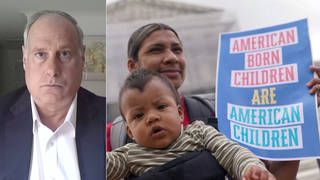
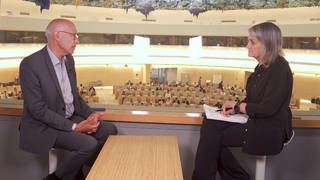
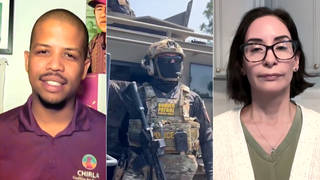
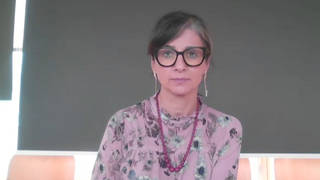
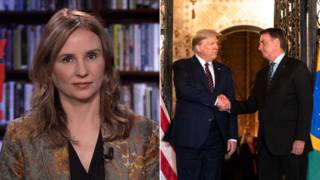
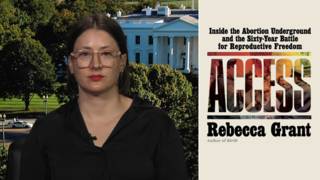
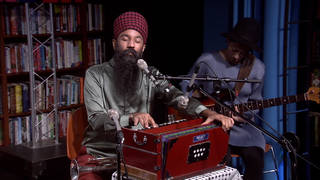

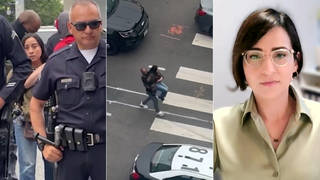

Media Options